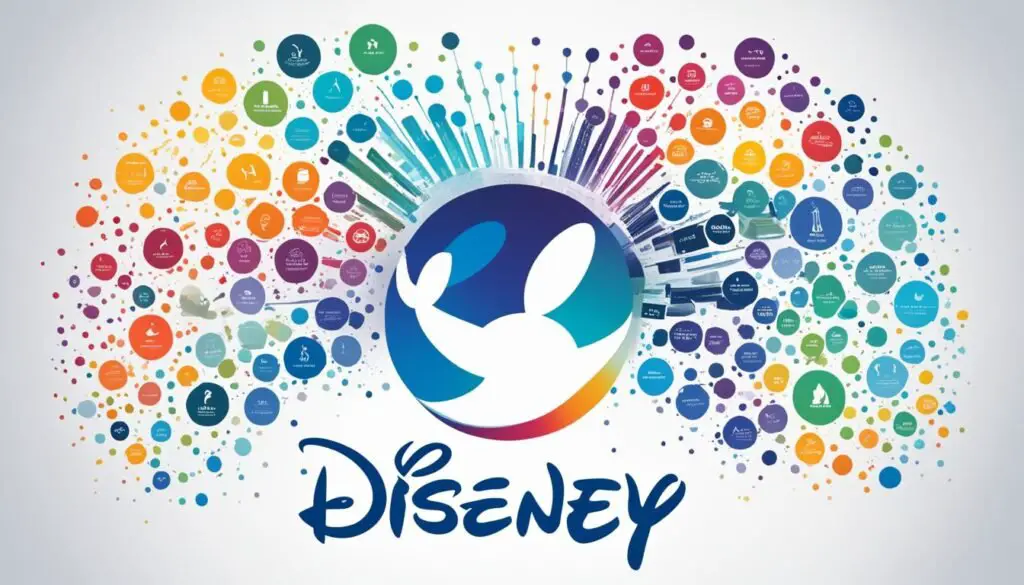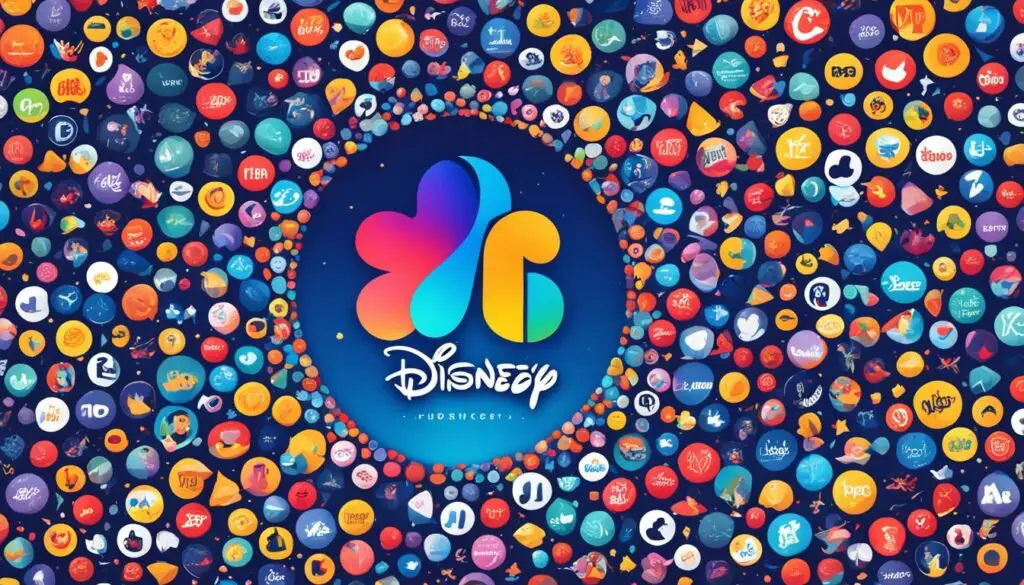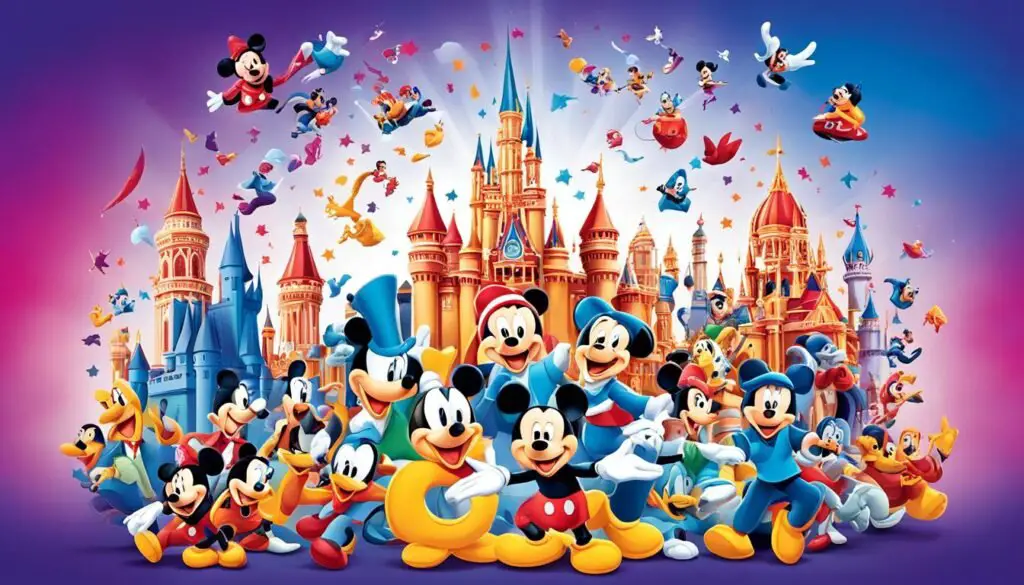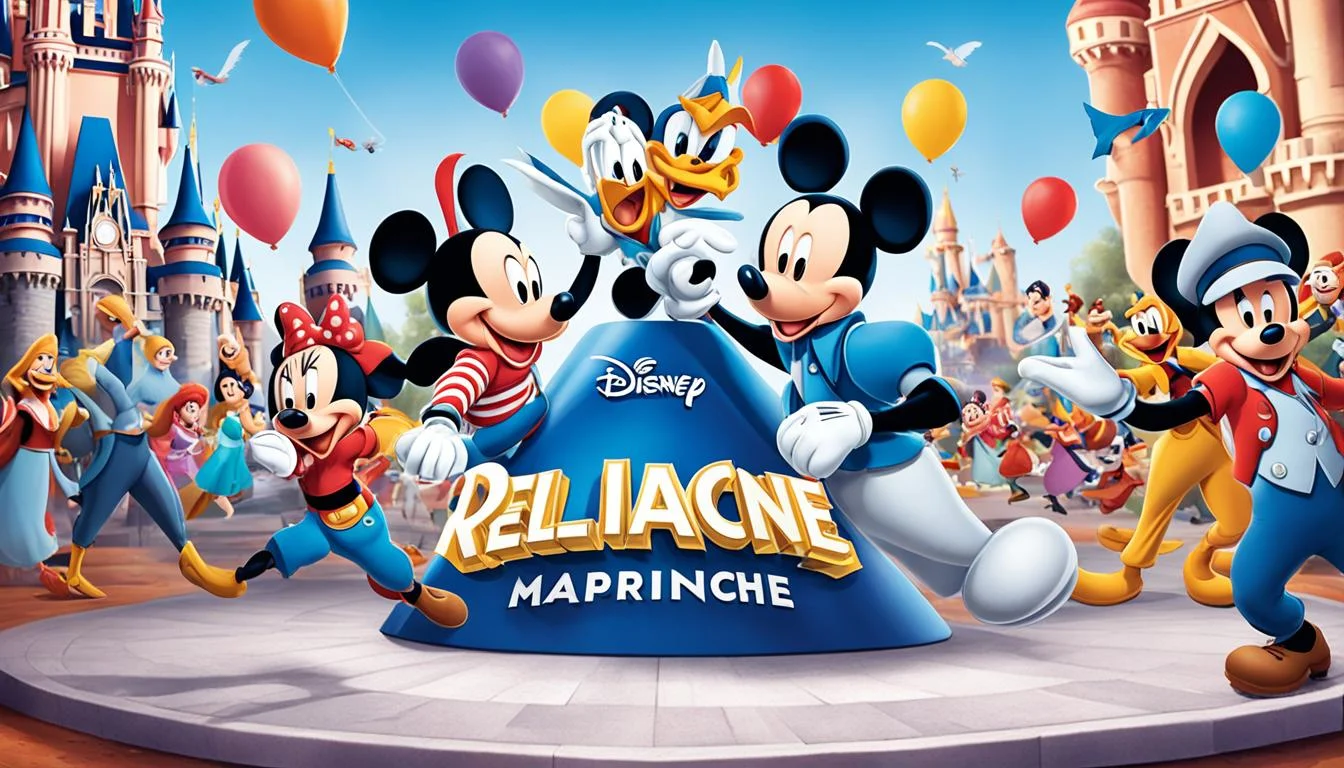Disney and Reliance have recently announced a groundbreaking agreement to merge their media operations in India, in a deal valued at $8.5 billion. This strategic move is set to reshape India’s media landscape and establish the largest media entity in the country. With Reliance controlling the joint venture and owning a 16.34% stake, Disney will have a 36.84% stake, while Reliance-backed Viacom18 will hold the majority stake at 46.82%. The merger is expected to transform the Indian market and open doors to new growth opportunities for both companies.
Thank you for reading this post, don't forget to subscribe!Key Takeaways:
- The Disney and Reliance merger in India’s media market is valued at $8.5 billion.
- Reliance will control the joint venture with a 16.34% stake, while Disney will have a 36.84% stake.
- Reliance-backed Viacom18 will hold the majority stake of 46.82%.
- The merger aims to reshape India’s media landscape and create the largest media entity in the country.
- Opportunities for growth and expansion in the Indian market are key drivers behind this landmark deal.
Overview of the Disney and Reliance Media Merger
The merger between Disney and Reliance in the Indian media sector marks a groundbreaking partnership that is set to have significant strategic implications for the global media landscape. The joint venture combines the strengths and resources of both companies, creating a powerful entity in the Indian entertainment sector. This merger not only consolidates their media assets but also paves the way for future growth and expansion. The deal is expected to have ripple effects on the global media industry, potentially shaping the way other companies approach partnerships and market opportunities.
Groundbreaking Partnership in the Indian Entertainment Sector
The merger between Disney and Reliance represents a significant milestone in the Indian entertainment sector. By joining forces, these industry giants are poised to establish the largest media entity in the country, revolutionizing the way entertainment is produced, distributed, and consumed in India. This partnership brings together Disney’s global expertise and Reliance’s deep understanding of the Indian market, creating a unique synergy that sets the stage for innovation and transformation in the industry.
Strategic Implications for the Global Media Landscape
The Disney and Reliance media merger not only has implications for the Indian entertainment sector but also reverberates throughout the global media landscape. This groundbreaking partnership showcases the growing importance of the Indian market and its potential for growth and investment. Additionally, the merger sets a precedent for other companies looking to expand their presence in India or form strategic alliances in emerging markets. This landmark deal could reshape the way the global media industry approaches partnerships and collaborations, opening new avenues for growth and creating a more interconnected and dynamic media ecosystem.
Valuation and Stake Distribution in the New Joint Venture
The valuation and stake distribution in the new joint venture reflect the significant investments and partnership dynamics between Disney, Reliance, and Viacom18. This merger represents a strategic move by both companies to capitalize on the immense potential of the Indian media market.
Reliance’s Future Investment in the Venture
Reliance, as the controlling entity in the joint venture, is committed to its future success and growth. As part of its investment strategy, Reliance plans to invest $1.4 billion into the joint venture. This significant financial commitment underscores Reliance’s confidence in the partnership and its belief in the long-term profitability of the Indian media industry.
Equity Breakdown between Disney, Reliance, and Viacom18
The equity breakdown in the new joint venture is as follows:
| Company | Stake |
|---|---|
| Reliance | 16.34% |
| Disney | 36.84% |
| Viacom18 | 46.82% |

This equity breakdown signifies the strategic positioning of each company in the merged entity. Reliance’s stake of 16.34% represents its controlling interest in the joint venture, allowing it to guide the overall direction and decision-making. Disney holds a significant stake of 36.84%, reflecting its commitment to the Indian market and its intention to leverage its global influence and content library. Viacom18, backed by Reliance, holds the majority stake of 46.82%, positioning it as a key player in the merged entity and enhancing its presence in the Indian media landscape.
The Impact of Disney’s Indian Market Valuation on the Merger
Disney’s Indian market valuation plays a significant role in the merger with Reliance, shaping the terms and conditions of the deal. Previously, Disney valued its India business at approximately $16 billion, highlighting the company’s confidence in the market and its potential for growth. However, as part of the merger agreement, the valuation has been revised to $8.5 billion, indicating a shift in perspective and reflecting the current market conditions and challenges.
Several factors contribute to this revised valuation, including the competitive landscape, regulatory dynamics, and the need to recalibrate expectations. The Indian media and entertainment industry has witnessed intense competition, evolving consumer preferences, and the rise of digital streaming platforms. These factors have likely influenced Disney’s reassessment of its India business valuation.
Despite the adjustment in valuation, the merger remains a strategic move for both Disney and Reliance, as it allows them to leverage their respective strengths and resources. Together, they create a powerful entity in the Indian media market, with a diversified portfolio and a broader reach. The merger presents an opportunity for them to tap into the immense potential of the Indian market and drive mutual growth.
Disney’s Past Valuation of Its India Business
Disney’s previous valuation of its India business at $16 billion demonstrates the company’s long-term commitment to the Indian market and its belief in the growth prospects of the media and entertainment industry. This valuation was driven by Disney’s investments in content creation, distribution platforms, and partnerships with local players.
However, the revised valuation in the merger agreement reflects the evolving market conditions and the need to assess the business’s intrinsic value accurately. The revised valuation takes into account various factors, including the competitive landscape, market saturation, and the financial performance of Disney’s India operations.
Expected Impairment Charges Due to the Merger
As part of the merger, Disney expects to incur impairment charges, primarily related to a write-down of the net assets of Star India, in the current quarter. These charges are estimated to be between $1.8 billion and $2.4 billion.
The impairment charges are a result of reassessing the fair value of the assets acquired by Disney through its previous acquisition of Star India. The revision of the valuation and the anticipated impairment charges are essential steps in aligning the financials with the current market reality and ensuring a fair and accurate assessment of the assets involved in the merger.
This adjustment allows both Disney and Reliance to establish a solid financial foundation for the joint venture, ensuring transparency and compliance with accounting standards. It also reflects the companies’ commitment to presenting a realistic assessment of the assets and liabilities involved in the merger.
Strategic Union of JioCinema and Disney+ Hotstar
The strategic union of JioCinema and Disney+ Hotstar is a key aspect of the Disney and Reliance merger. By combining these two platforms, the joint venture aims to pool their resources and create a digital streaming powerhouse. This strategic move sets the foundation for delivering high-quality content and services to consumers in India.
The merger between JioCinema and Disney+ Hotstar brings together their respective strengths and expertise in content creation and distribution. JioCinema, a leading digital platform in India, offers a wide range of movies, TV shows, and original content, while Disney+ Hotstar provides access to Disney’s vast library of movies, TV shows, and exclusive originals.
The strategic union allows the joint venture to leverage JioCinema’s extensive user base and digital infrastructure with Disney+ Hotstar’s premium content, brand recognition, and global appeal. Together, they can offer a comprehensive and compelling streaming experience to audiences in India.

As the Indian market continues to embrace digital streaming, this merger positions the joint venture as a dominant player in the premium content streaming space. The combined strengths of JioCinema and Disney+ Hotstar create an unparalleled offering for Indian audiences, providing a diverse range of content across genres, languages, and formats.
The future of premium content streaming in India looks promising with the strategic union of JioCinema and Disney+ Hotstar. This collaboration will not only drive innovation but also shape the evolving preferences of Indian audiences. By pooling their resources and expertise, the joint venture is well-positioned to deliver an exceptional streaming experience and establish itself as a digital streaming powerhouse in India.
The Competitive Landscape of Indian Media Giants
The Indian media industry is experiencing significant changes in its competitive landscape, with recent strategic shifts and developments reshaping the industry. As major players in the market reevaluate their strategies and explore new opportunities, the merger between Disney and Reliance comes at a critical juncture.
Strategic partnerships and alliances are becoming increasingly important for long-term success in the Indian media industry. One notable development in this regard is Sony’s recent withdrawal from merger discussions with Zee Entertainment, marking the end of two years of deliberation for a potential $10 billion media powerhouse. This decision highlights the dynamic nature of the Indian media landscape and the complexities involved in forging partnerships.
The competitive landscape of Indian media giants is constantly evolving, as companies adapt to changing market dynamics and seek to strengthen their positions. This dynamic environment necessitates strategic shifts and collaborative efforts to navigate the ever-growing competition and capitalize on emerging opportunities.
| Indian Media Giants | Key Strategic Shifts |
|---|---|
| Disney and Reliance | Merging their media operations to create a powerful entity and capitalize on the growing Indian market. |
| Sony and Zee Entertainment | Ending merger discussions after two years of deliberation, signaling a shift in strategic priorities. |
| Other major players in the Indian media industry | Exploring new partnerships, acquisitions, and business models to enhance their market positioning. |
Disney, Reliance Sign $8.5 Billion Deal to Merge India Media Operations
Disney and Reliance have officially signed an $8.5 billion deal to merge their media operations in India. This landmark agreement brings together two industry leaders and signals a significant shift in the Indian media landscape. The joint venture is expected to create a powerhouse in the Indian market, leveraging the combined strengths of both companies. The deal is subject to regulatory and shareholder approvals, with a projected completion date by the end of March 2025.

| Deal Value | Parties Involved | Projected Completion Date |
|---|---|---|
| $8.5 billion | Disney and Reliance | March 2025 |
Disney’s Evolution in the Indian Market
Disney’s presence in the Indian market has experienced a dynamic evolution, guided by strategic acquisitions and expansion strategies. One pivotal move was the acquisition of Hotstar, a leading streaming platform, which enabled Disney to aggressively expand into Southeast Asian streaming markets. This acquisition proved to be a significant catalyst for Disney’s growth and influence in the Indian media landscape.
However, as the competition in the Indian market intensified, Disney encountered subsequent challenges and faced streaming losses. The highly competitive nature of the market necessitated a careful reevaluation of Disney’s approach and necessitated the development of effective strategies to mitigate risks.

As Disney charts its path forward, the merger with Reliance represents a strategic endeavor to solidify its position in the Indian market. With a focus on long-term success, Disney aims to leverage its expertise, resources, and the synergies between the two entities to overcome challenges and sustain growth in the ever-evolving Indian media landscape.
| Disney’s Evolution in the Indian Market | Acquisitions | Expansion Strategies | Challenges | Streaming Losses |
|---|---|---|---|---|
| Acquisition of Hotstar |
|
|
|
|
| Merger with Reliance |
|
|
Mukesh Ambani’s Vision for the Entertainment Industry
Mukesh Ambani, the chairman of Reliance Industries, has a clear vision for the entertainment industry and the pivotal role that Reliance plays within it. With its growing media footprint and recent ventures like Viacom18, Reliance signifies its unwavering commitment to the entertainment sector. Ambani envisions a new era of entertainment in India, one that is defined by ample resources, unmatched creative prowess, and affordable prices that cater to audiences nationwide.
Reliance’s Growing Media Footprint
Reliance’s foray into the media industry has been marked by an expansive and ever-growing footprint. Its ventures, such as Viacom18 and the recent merger with Disney, demonstrate Reliance’s strategic positioning in the entertainment landscape. Through these partnerships, Reliance aims to strengthen its presence and influence in the Indian media market, solidifying its position as a formidable player.
Ambani’s Statement on the New Era of Entertainment
“The merger between Disney and Reliance marks the beginning of a new era in the entertainment industry. We envision a future where a remarkable fusion of creativity, technology, and accessibility defines the entertainment experience for all Indians. This merger allows us to revolutionize the landscape, offering a diverse range of content and services that cater to the evolving needs and aspirations of our audiences.”
– Mukesh Ambani
The Synergy of Contents and Rights between Disney and Reliance
Exclusive Broadcasting Rights of Major Cricket Tournaments
Access to Diverse and Rich Entertainment Libraries
The merger between Disney and Reliance unlocks a synergy of contents and rights, creating new possibilities in the Indian media market. One of the key benefits of this joint venture is the exclusive broadcasting rights to major cricket tournaments, capitalizing on the immense popularity of the sport in India. This strategic partnership positions the merged entity as a dominant player in the sports broadcasting landscape, enabling them to provide extensive coverage and captivating content to cricket enthusiasts across the nation.
In addition to the sports broadcasting rights, the merger grants the joint venture access to diverse and rich entertainment libraries, including Disney’s extensive collection. This allows for the creation of a comprehensive and compelling content offering that caters to a wide range of audience preferences. By combining their entertainment resources, Disney and Reliance can deliver unparalleled content experiences, further solidifying their presence and influence in the Indian media and entertainment industry.
| Key Highlights | Benefits |
|---|---|
| Exclusive broadcasting rights to major cricket tournaments | 1. Capitalizing on the immense popularity of cricket in India 2. Extensive coverage and captivating content for cricket enthusiasts |
| Access to diverse and rich entertainment libraries | 1. Comprehensive and compelling content offering 2. Serving a wide range of audience preferences |
Operational Details and Expected Timeframe of the Merger
The operational details and expected timeframe of the merger between Disney and Reliance provide valuable insights into the partnership’s execution. This section outlines the anticipated regulatory and shareholder approvals, as well as the projected completion date for the joint venture.
Anticipated Regulatory and Shareholder Approvals
Before the merger can be finalized, it is subject to various regulatory and shareholder approvals. Regulatory bodies will carefully review the merger to ensure compliance with relevant laws and regulations. Shareholder approvals will be sought to obtain the necessary consent from both Disney and Reliance shareholders.
Projected Completion Date for the Joint Venture
The joint venture aims to complete the merger by the end of March 2025. This projected completion date allows sufficient time for the necessary approvals and ensures a smooth transition for both companies. By leveraging their combined strengths and resources, Disney and Reliance will position themselves strategically in the Indian media market.
Role of Uday Shankar and James Murdoch in the Merged Entity
The role of Uday Shankar and James Murdoch in the merged entity holds significant importance, as they bring their expertise and experience to the partnership. Uday Shankar, the former CEO of Star India, reunites with the business he previously built over a decade. James Murdoch, through his investment vehicle Bodhi Tree, also reunites with previous ventures. This reunion of key industry players showcases the trust and confidence placed in their capabilities to drive the future success of the joint venture.
Reuniting with Previous Ventures
For Uday Shankar, the merger presents an opportunity to reunite with Star India, a business he played a pivotal role in shaping. Having led Star India to become one of the country’s leading media companies, Shankar’s return to the merged entity reinforces his position as a veteran in the Indian media landscape.
Similarly, James Murdoch’s investment vehicle Bodhi Tree facilitates the reunion with his previous ventures. The merger allowed Murdoch to leverage his extensive industry knowledge and experience gained through various investments and partnerships, further strengthening the strategic leadership of the merged entity.
Strategic Leadership Positions Post-Merger
Following the merger, Uday Shankar and James Murdoch will assume strategic leadership positions in the combined entity. Drawing on their proven track records and deep understanding of the media industry, they will guide the joint venture to navigate future market challenges and seize opportunities for growth.
Both Shankar and Murdoch will play instrumental roles in formulating and executing the merged entity’s strategic vision, shaping its growth trajectory, and ensuring its positioning as a dominant player in the Indian media and entertainment industry.
Disney’s Strategy to Mitigate Risk in the Indian Market
In the context of the merger with Reliance, Disney has devised a strategic approach to mitigate risk in the Indian market. This consideration is crucial as both companies aim to navigate the challenges and seize the opportunities presented by the Indian media landscape.
Analyst Perspectives on Disney’s Minority Stake Approach
Analyst perspectives shed light on Disney’s minority stake approach, which allows the company to maintain exposure to the significant growth potential in the Indian market while mitigating risks. By holding a minority stake in the joint venture, Disney can leverage its expertise and resources without assuming excessive volatility. Analysts view this approach as a prudent strategy that enables Disney to tap into the Indian market’s immense potential while minimizing potential downsides.
Disney’s Ongoing Adjustments under CEO Bob Iger
Under the leadership of CEO Bob Iger, Disney has consistently made ongoing adjustments to its business strategies to ensure long-term success. These adjustments involve assessing market dynamics and making proactive decisions to optimize operations and drive growth. In the context of the Indian market, Disney’s merger with Reliance represents a strategic move that aligns with the company’s broader objectives and its commitment to adapt and thrive in an ever-evolving media landscape.
Conclusion
The merger between Disney and Reliance is not only significant for the market positioning of these two industry giants, but it also has far-reaching implications for the entire Indian media and entertainment industry. This landmark deal creates a powerhouse that combines the strengths of Disney and Reliance, placing them in a prime position to exploit the immense potential of the growing Indian market. The completion of this merger sets the stage for driving innovation, delivering exceptional content, and catering to the evolving needs of Indian audiences.
The significance of this merger extends beyond the immediate impact on Disney and Reliance. It has the potential to shape the future landscape of the Indian media and entertainment industry as a whole. By leveraging their resources and expertise, the joint venture can influence industry dynamics, redefine market standards, and propel the industry forward. The merger represents a strategic move that signifies the commitment of both companies to long-term growth and success in India.
With the combined expertise, content libraries, and broadcasting rights brought by Disney and Reliance, the joint venture is well-positioned to dominate the Indian media and entertainment landscape. This merger opens up new avenues for collaboration, content creation, and distribution, catering to the diverse preferences of Indian audiences. As the Indian market continues to evolve, this partnership has the potential to redefine the way entertainment is consumed and enjoyed in the country, setting new benchmarks for quality, innovation, and customer experience.
In conclusion, the Disney and Reliance merger is a game-changer in the Indian media and entertainment industry. This union consolidates the strengths of two industry leaders and creates a powerhouse that is poised to shape the future of the Indian market. As the joint venture progresses, it will be interesting to see how this merger unfolds, with the potential to drive industry-wide transformation and set a new standard for excellence in the Indian media and entertainment landscape.
FAQ
What is the significance of the Disney and Reliance media merger deal?
How is the valuation and stake distribution in the new joint venture?
What impact does Disney’s Indian market valuation have on the merger?
What is the strategic union between JioCinema and Disney+ Hotstar?
When is the expected completion date for the merger?
What is the role of Uday Shankar and James Murdoch in the merged entity?
What is Disney’s strategy to mitigate risk in the Indian market?
What is the significance of the merger for Disney and Reliance’s market positioning?
Source Links
- https://techcrunch.com/2024/02/28/reliance-buys-majority-stake-in-disney-india-business/
- https://www.latimes.com/entertainment-arts/business/story/2024-02-28/disney-merges-india-media-business-with-reliance-venture-in-8-5-billion-deal
- https://www.cnbc.com/2024/02/28/disney-and-reliance-to-merge-media-businesses-in-india.html





